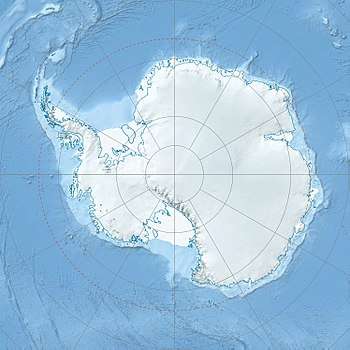Criosfera 1
The Criosfera 1 is a Brazilian standalone research module for atmospheric data collection, prepared at the National Institute for Space Research (INPE) for the Brazilian Antarctic Program (PROANTAR).
Criosfera 1 | |
|---|---|
 Criosfera 1 | |
| Coordinates: 84°00′S 79°30′W | |
| Country | |
| Territory | Brazilian Antarctica |
| Established | 12 January 2012 |
| Website | PROANTAR |
Location
Inaugurated on 12 January 2012, the module is located on the plateau of the western Antarctica ice sheet, at 84°00' S–79°30' W, 420 kilometres (260 mi) from the Union Glacier, 670 kilometres (420 mi) from the geographical South Pole, and 2,500 kilometres (1,600 mi) south of the Comandante Ferraz Brazilian Antarctic Base.
Expedition Criosfera 1
The expedition for the placement of the module was coordinated by Universidade Federal do Rio Grande do Sul (UFRGS) through Professor Jefferson Cardia Simões, director of the Centro Polar e Climático (CPC). The Universidade Estadual do Rio de Janeiro (UERJ), was then represented by Professor Dr. Heitor Evangelista, responsible for the coordination of the project.[1]
Measuring 6.3 metres (21 ft) long, 2.6 metres (8.5 ft) wide, 2.5 metres (8.2 ft) high, and comprising a weight of 3,500 kilograms (7,700 lb), it was planned at 1.5 metres (4.9 ft) above the ground to avoid snow accumulation, allowing so the passage of the winds. Among the scientific tasks developed by the staff are ice drilling, assembly and activation of the module, and the surveying of ice morphology and dynamics at the glacier.
Objective
The first Brazilian fully automatic data-collecting scientific module placed inside the Antarctic continent is intended for data collection concerning the analysis on reflexes of the pollutants generated in South America and in Antarctica. Data will be sent via satellite directly to the computers of the national institute (INPE).[2]
References
- Moraes, Flávia (24 October 2011). "Expedição Criosfera leva módulo científico brasileiro para o interior da Antártica" (in Portuguese). Eco Agencia. Retrieved 29 February 2012.
- Motta, Cláudio (12 January 2012). "Pesquisadores brasileiros na Antártica encerram a expedição". Globo Ciencia (in Portuguese). Retrieved 29 February 2012.
.svg.png)